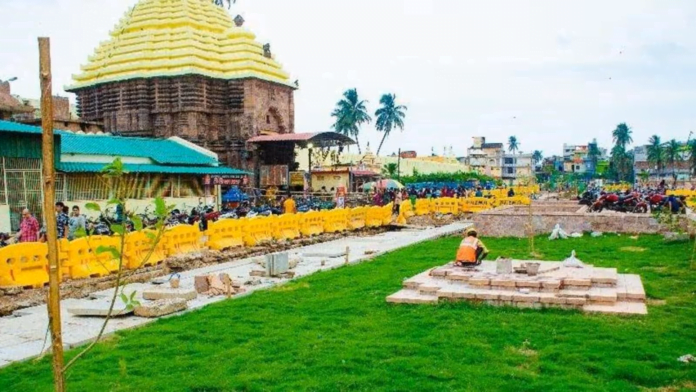
Priyanshi Pareek
The highly anticipated Srimandir Parikrama project, aimed at enhancing the surroundings of the iconic Jagannath temple in Puri, is underway with an investment of Rs. 943 crore.
The Parikrama project is nearing its final stages and is set to be unveiled to the public on January 17, 2024. A special puja and havan will mark the inauguration on that day.
Shree Jagannath Temple administration chief administrator Ranjan Kumar Das said the inauguration ceremony on January 17 would be on a massive scale with devotees from India and abroad thronging the event.
“The people who had visited Puri ten years back will notice a huge difference now. I am sure the devotees will get a cosmopolitan feeling while visiting Puri after the project’s inauguration,” said Das.
The officials mentioned that the Shree Setu, a pioneering 1.5 km long and 60-metre wide trumpet bridge in Odisha, intended to facilitate vehicle access from Bhubaneswar and Brahmagiri to the Jagannath Vallabh parking near the temple, won’t be completed until February of the following year. Land acquisition commenced in November 2019, involving more than 600 residents around the temple who willingly surrendered 15.64 acres crucial for establishing the security zone and enabling the project’s development.
Following a three-bench judgement in November 2019, led by Justice Arun Mishra, the Supreme Court mandated the clearance of all structures within a 75-metre radius around the temple for safety, security, and the temple’s enhancement.
In November 2021, Chief Minister Naveen Patnaik initiated the project by laying the foundation stone for the development within the 75-metre corridor along the boundary wall of the Jagannath temple, aiming to convert it into a significant pilgrim centre.
The project faced setbacks due to the COVID-19 pandemic and the issuance of draft by-laws by the National Monuments Authority (NMA) in January 2021, which initially prohibited construction within a 100-metre radius of the temple and restricted further construction within an additional 200-metre radius without NMA approval. However, following a request from the chief minister, these by-laws were withdrawn.
In June of the same year, the Supreme Court dismissed two PILs challenging the renovation project, deeming them as “frivolous litigation.” In February, the Archaeological Survey of India in Puri intervened, instructing the state government to halt digging, citing potential violations of the Ancient Monuments and Archaeological Sites and Remains Act.
The case reached the Orissa High Court, with the ASI submitting in an affidavit that the excavation might have led to the destruction of archaeological remains due to the absence of heritage impact assessment studies before the digging commenced.
However, in September of the same year, all obstacles were resolved as the NMA granted a “no-objection certificate” for the construction of the reception centre – a pivotal element of the project – located just outside the restricted zone.
Once finalised, the centre will boast modern amenities, catering to 6,000 devotees with a queue management system, baggage screening, a cloakroom for nearly 4,000 families, water and toilet facilities, hand/feet washing areas, information-cum-donation kiosks, shade pavilions, multi-level car parking, emergency lanes for police and emergency vehicles, an integrated command centre, and a souvenir shop, among other facilities.
State government officials highlighted the significance of the Parikrama project, stating that unlike the other three major Dhams, Puri lacked a designated parikrama marg. Given Puri’s status as the religious capital of Odisha and its daily footfall of nearly 40,000 visitors, there was a pressing need to revitalise the surrounding area. Earlier, the temple periphery suffered from clutter due to illegal constructions and mutts, as mentioned by Das.
Alongside the temple project, the state government is investing an additional Rs. 3,300 crore to overhaul Puri’s infrastructure through the Augmentation of Basic Amenities and Development of Heritage and Architecture (ABADHA) scheme.
For the ruling Biju Janata Dal (BJD), the unveiling of the Parikrama project before the upcoming assembly elections holds significant weight, alleviating many of their concerns.
Political analyst SP Das remarked that the inauguration of the temple project would strongly resonate with the people, as Lord Jagannath holds immense significance as the greatest symbol of identity for the Odia community. The state’s history, culture, traditions, and belief systems are deeply rooted in the temple, further solidifying Chief Minister Patnaik’s connection with the populace.

